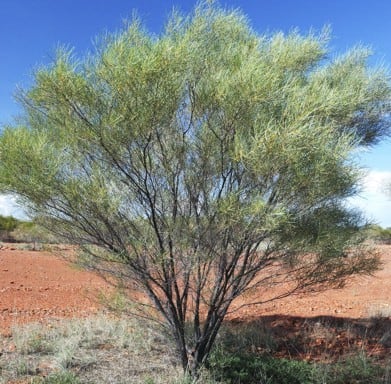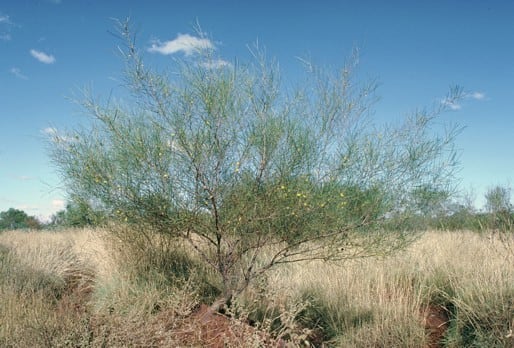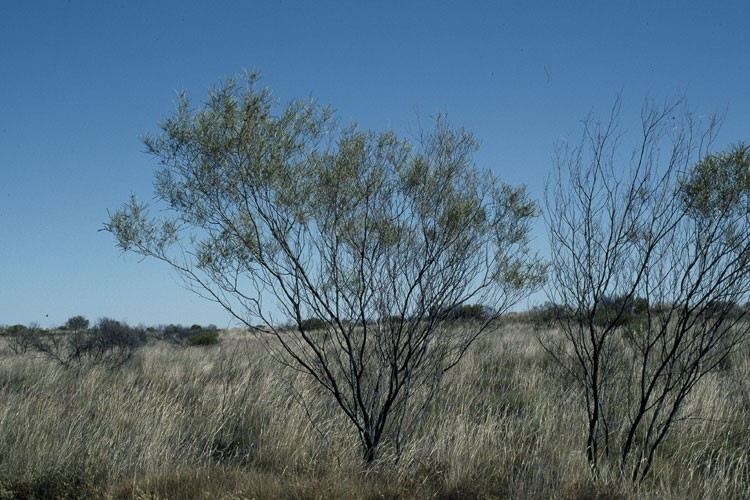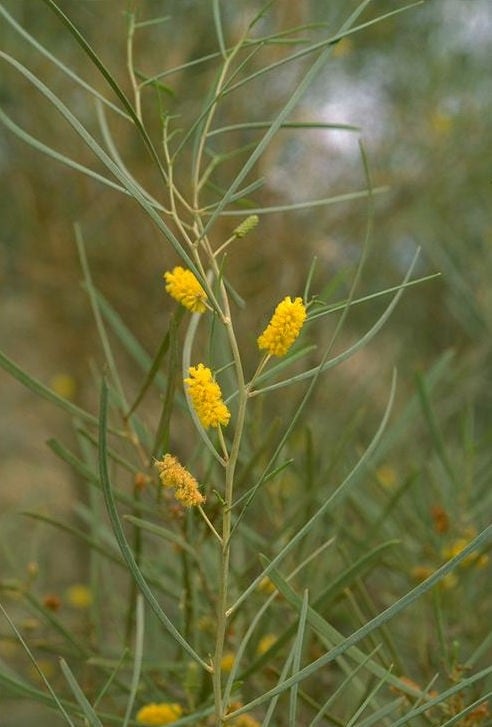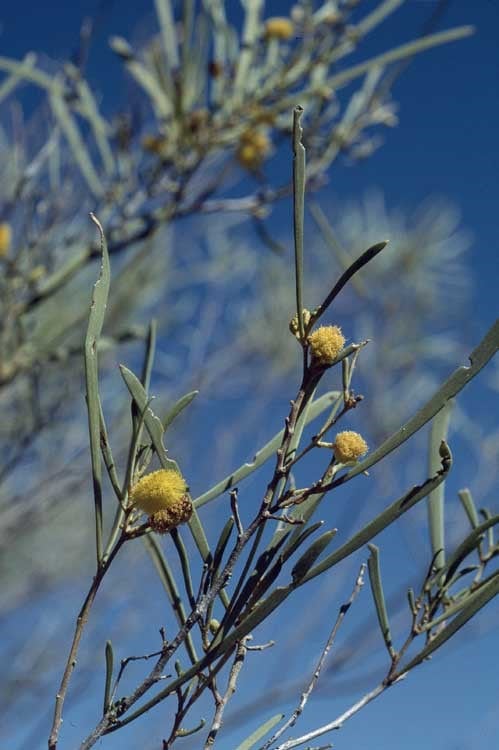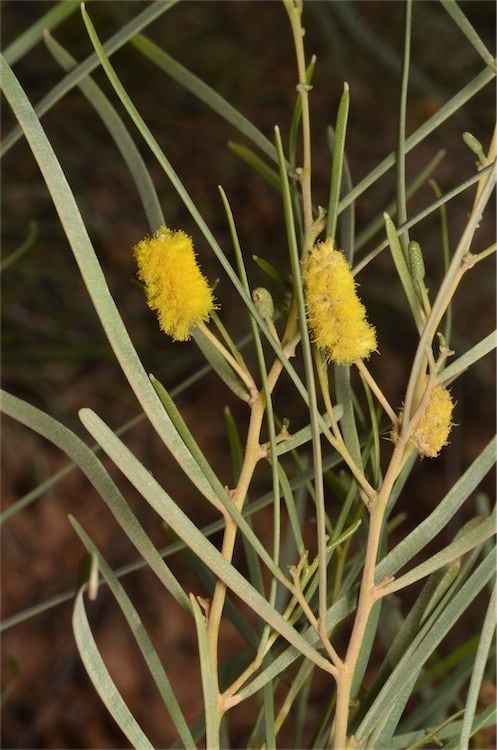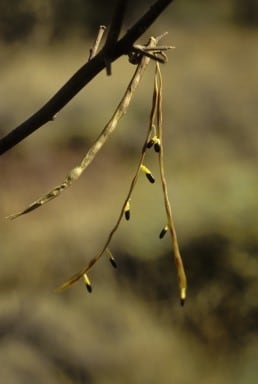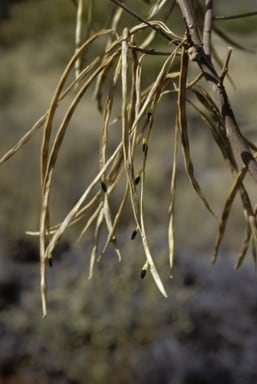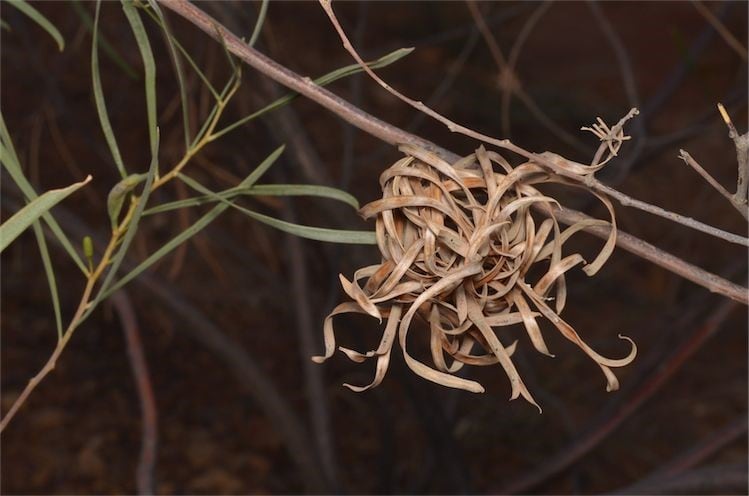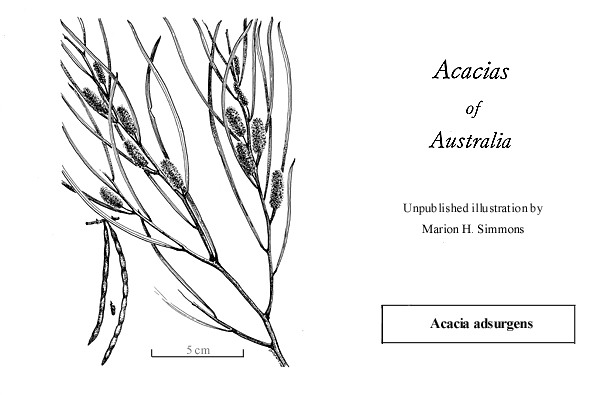Acacia adsurgens Maiden & Blakely
WATTLE
Acacias of Australia
Common Name
Whipstick Wattle, Sugar Brother
Family
Fabaceae
Distribution
Widespread in W.A., N.T. and Qld between 18ºS and 26ºS, extending to c. 117ºE in the west near Roebourne, and E to central Qld; also occurs in far north-eastern S.A. in the Lake Eyre region.
Description
Spreading, multi-stemmed shrub mostly 1–4 m tall. Bark grey to reddish brown, mostly smooth but sometimes rough and somewhat fibrous at base of main stems on oldest plants. Branchlets angular to flattened towards apices, light brown or reddish, glabrous. Phyllodes linear, straight or upwardly curved, flat, (8–) 10–18 (–20) cm long, (1–) 2–4.5 (–8) mm wide, coriaceous, usually pale yellowish green or milky green when dry, glabrous; longitudinal nerves numerous with central nerve more pronounced than the others, the minor nerves obscure and c. 8–10 per mm; gland 1, basal, swollen, to 3 mm above pulvinus. Peduncles 5–15 mm long, often c. as long as the spikes. Spikes 0.8–2.5 cm long, densely flowered, yellow. Flowers 5-merous; calyx 0.8–1.25 mm long (exceeding ½ length of corolla), dissected by less than 1/10, with densely scurfy viscid lobes and midrib commonly evident; corolla 1.2–1.8 mm long, dissected to c. 1/3 its length, glabrous; ovary glabrous or apex very finely tomentose. Pods linear, slightly raised over and constricted between seeds, straight or slightly curved, 3.5–12 cm long, 2–3.5 mm wide, firmly chartaceous to thinly crustaceous, light brown. Seeds longitudinal, narrowly oblong to oblong-elliptic, dorsiventrally flattened, 3–4.5 mm long, dark brown to blackish; areole small, open with U-shaped pleurogram, paler than rest of seed; aril rather large, convoluted and bright yellow.
Phenology
Flowers May–Sept., sometimes as early as Feb.
Habitat
Grows in reddish sandy and gravelly soils, on flat plains and hillsides, commonly in spinifex grassland communities, sometimes with eucalypts. Moderately fast-growing but relatively short-lived species that regenerates from seed following fire or other disturbance and can form rather dense, localized thickets, especially where water is not limiting.
Specimens
W.A.: c. 80 km NW of Wittenoom on the road to Roebourne, B.R.Maslin 5570 (NSW, PERTH). N.T.: 30 miles [48 km] E [of] Connors Well, N.Forde 950 (DNA, NSW); 26 miles [41.6 km] W of Avon Downs Stn, on the Barkly Hwy, I.V.Newman 575 (NSW). S.A.: Innaminka Regional Reserve, Innaminka–Cordillo road c. 40 km N of Candradecka Dam, R.W.Purdie 4547 (AD s.n., CANB s.n.). Qld: Brenda Bore, Oban Stn, c. 62 miles [99.8 km] SW of Mount Isa, S.L.Everist 3372 (BRI).
Notes
Most closely related to A. tenuissima (with which it is sometimes sympatric) that is most readily distinguished by having slender, terete phyllodes. Superficially similar to linear phyllode forms of A. sibirica from the Pilbara, W.A., which are distinguished by generally shorter phyllodes (mostly 40–90 mm long) that are uniformly finely nerved (the mid-nerve not more pronounced than the rest), less densely flowered spikes (with smaller flowers and calyx shorter relative to the corolla) that are commonly about twice as long as the peduncles, and broader pods. Also related to the Pilbara endemic Acacia sp. Jimblebar (S.van Leeuwen 1342). Possibly hybridizes with A. rhodophloia in the central Hamersley Ra., W.A. (see A. adsurgens × rhodophloia for discussion).
Details of ecology, utilisation, etc. of A. adsurgens are given in L.A.J.Thomson & N.Hall, Austral. Acacias no. 22, CSIRO Division of Forestry & Forest Products (1989). Details of fire impacts on, and Aboriginal use of, A. adsurgens are given by P.Latz, Bushfires & Bushtucker 86 (1995).
A specimen from the Gibson Desert, W.A., has atypically wide phyllodes (A.S.George 15658, BRI, PERTH).
FOA Reference
Data derived from Flora of Australia Volumes 11A (2001), 11B (2001) and 12 (1998), products of ABRS, ©Commonwealth of Australia
Author
Edited by B.R.Maslin
Dr M.D.Tindale and Dr P.G.Kodela with the assistance of M.Bedward, S.J.Davies, C.Herscovitch, D.A.Keith and/or D.A.Morrison
This identification key and fact sheets are available as a mobile application:
URL: https://apps.lucidcentral.org/wattle/
© Copyright 2018. All rights reserved.
